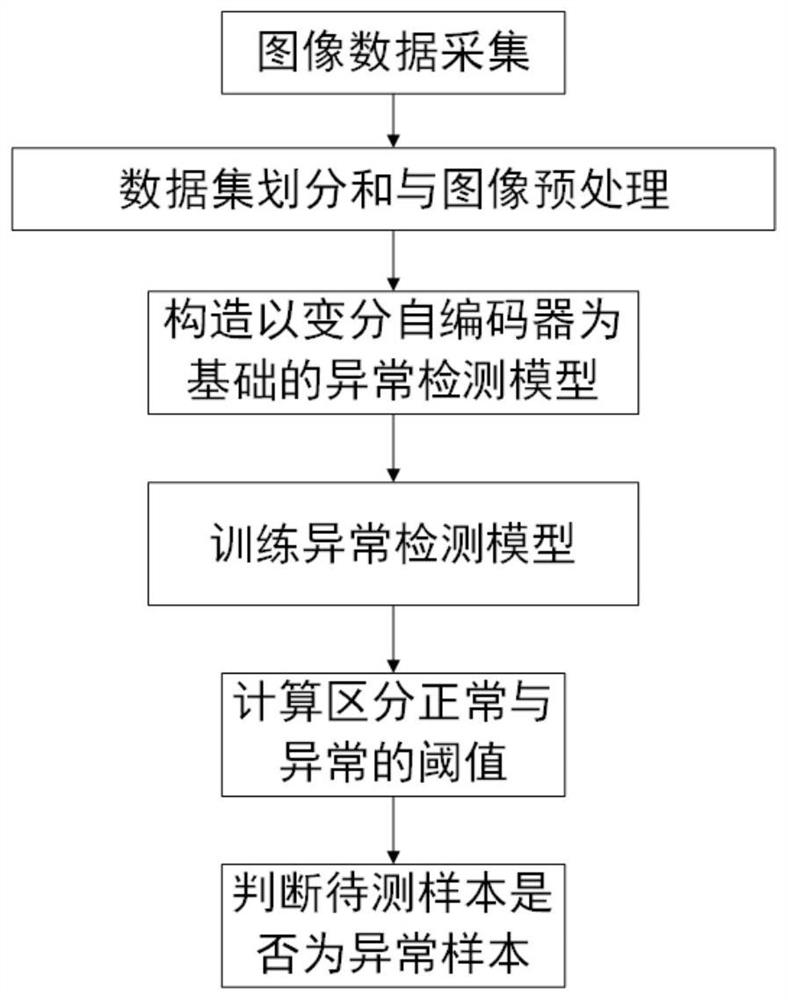Image Anomaly Detection Method Based on Variational Autoencoder
A self-encoder and anomaly detection technology, applied in the field of deep learning, can solve problems such as limited application, high memory complexity, and inability to affect hidden layer features, and achieve the effect of fast testing and low memory complexity
- Summary
- Abstract
- Description
- Claims
- Application Information
AI Technical Summary
Problems solved by technology
Method used
Image
Examples
Embodiment 1
[0027] Anomaly detection has a wide range of applications in many fields. Among the anomaly detection technologies that have been researched and developed, it involves detection scenarios such as credit card fraud detection, network intrusion detection, medical diagnosis, and image denoising. Considering that images play an important role in conveying information in today's information age, it is of great significance to perform anomaly detection on images and subsequently analyze or delete the detected anomalous images. The present invention addresses the problem of anomaly detection with respect to images.
[0028]The number of exploding images puts forward new requirements for anomaly detection, which makes traditional anomaly detection methods difficult to deal with, and deep anomaly detection methods occupy the mainstream position. The anomaly detection methods represented by autoencoders and variational autoencoders have certain shortcomings, which limit their ability to...
Embodiment 2
[0043] The image anomaly detection method based on variational autoencoder is the same as that of Embodiment 1, and the calculation of the feature corresponding to each normal image sample in the training set in step (3a) needs to calculate the mean and standard deviation of the feature corresponding to each normal image sample, Finally, the features are sampled from the standard normal distribution and calculated. Specific steps are as follows:
[0044] 3a1) Calculate the mean of the features corresponding to each normal image sample in the training set
[0045] Calculate each normal image sample x in the training set according to the following formula i The mean μ of the corresponding feature i :
[0046] μ i =Relu(y i,K )W 1,K+1 +b 1,K+1
[0047]
[0048] where μ i Represents the mean value of the feature corresponding to the ith normal image sample in the training set, Relu represents the linear rectification function Rectified Linear Unit, here as the activati...
Embodiment 3
[0060] The image anomaly detection method based on the variational autoencoder is the same as the embodiment 1-2, and the specific formula of the reconstructed sample corresponding to each normal image sample in the calculation training set in step (3b) is as follows:
[0061]
[0062]
[0063] in, Represents the reconstructed sample corresponding to the ith normal image sample in the training set, Sigmoid represents the activation function, y i,M Represents the output of the activation function of the ith normal image sample in the Mth hidden layer of the decoder part of the variational autoencoder, M represents the number of hidden layers after the feature layer and before the output layer, W 2,M+1 represents the weight matrix of the Mth hidden layer of the decoder part of the variational autoencoder mapped to the output layer, b 2,M+1 The bias vector representing the mapping of the Mth hidden layer of the decoder part of the variational autoencoder to the output lay...
PUM
 Login to View More
Login to View More Abstract
Description
Claims
Application Information
 Login to View More
Login to View More - R&D
- Intellectual Property
- Life Sciences
- Materials
- Tech Scout
- Unparalleled Data Quality
- Higher Quality Content
- 60% Fewer Hallucinations
Browse by: Latest US Patents, China's latest patents, Technical Efficacy Thesaurus, Application Domain, Technology Topic, Popular Technical Reports.
© 2025 PatSnap. All rights reserved.Legal|Privacy policy|Modern Slavery Act Transparency Statement|Sitemap|About US| Contact US: help@patsnap.com



